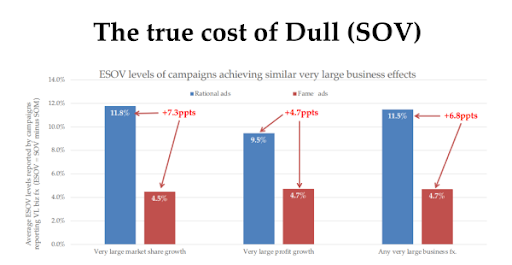The £10m cost of dull advertising | WARC | The Feed
The Feed
Read daily effectiveness insights and the latest marketing news, curated by WARC’s editors.
You didn’t return any results. Please clear your filters.

The £10m cost of dull advertising
Any campaign can be successful if you throw enough money at it, but a dull campaign will cost you tens of millions more a year more to match the performance of an exciting and well-thought-out campaign, according to marketing consultant Peter Field.
Why it matters
“Dull is expensive commercially, because you have to put so much more effort and money to land the dull message than an interesting one,” says Adam Morgan of eatbigfish, who’s currently developing the ‘Cost of Dull’ project with Field and System1. He adds that dull is also expensive because it’s “excluding”, for both consumers and colleagues.
Putting a price on dull
Initial research undertaken by Field, in his usual hunting ground of the IPA Effectiveness Awards database, came up with the £10m figure and that’s just an average – it can be double in some categories where share of voice is more expensive.
Takeaways
- Campaigns pursuing dull advertising have far larger budgets than the ones that are not dull – “to the extent of 11 points of Share of Voice”, Field reports.
- It’s already costly to buy Share of Voice in categories like retail and durables; a dull campaign here will lead to an extra £20m a year to match the effects of an interesting campaign.
- The road to tedium is paved with good intentions: no one consciously wants to be dull but corporate metrics will often push marketers down that path; and if dull is the category norm it can be difficult to take risks.
- Years of focus on performance marketing has driven short-term, bottom-of-funnel sales, but that sort of creative approach has also been applied to top-of-funnel marketing where it is much less effective.
Key quote
“We’re not saying dull campaigns are ineffective. It’s just they do not work very hard. And you get a much, much bigger performance out of these more exciting campaigns – it can be six or seven times greater for every euro, dollar or pound you put behind them” – Peter Field.
The definition of dull
Dull campaigns occupy one end of the spectrum, being all about information and using facts to persuade. At the opposite end are “fame” campaigns, using emotions to engage consumers and get them talking about a brand.
Sourced from Let’s Make This More Interesting
[Image: Peter Field]
Email this content
